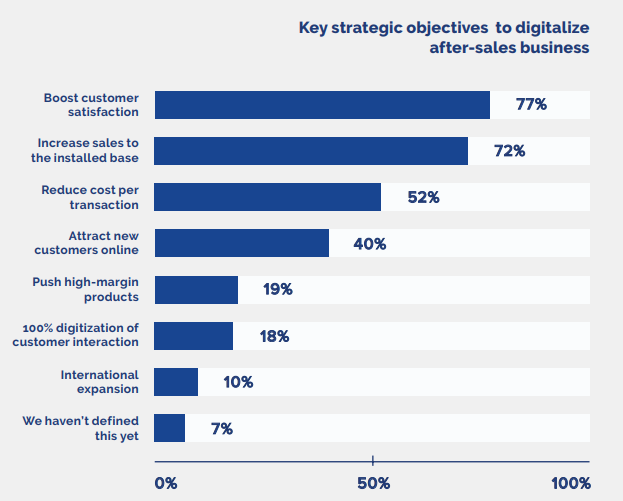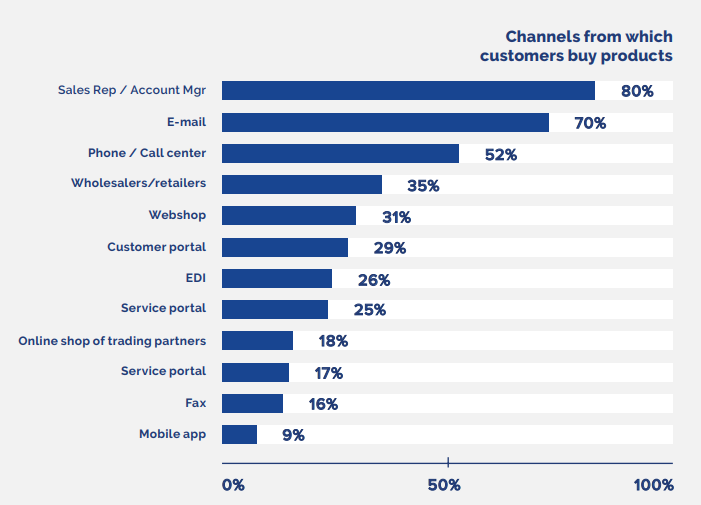The status of ecommerce within manufacturing

Manufacturers increasingly want to digitize their sales- and buying processes. But what is the current maturity level of their online sales- and services capabilities? And how does it come that manufacturers act so protective in the after-sales business?
Technology keeps on growing exponentially and this has consequences for the b2b industry. Customer expectations rise and the competition, both nationally and internationally, grows fiercer. So, the digital innovation capability of manufacturers must accelerate too.
The state of digital innovation within manufacturing
In ‘The state of digital innovation within manufacturing’ 125 ecommerce leaders were surveyed. The report wants to determine where these companies stand and give them tips for overcoming their digitization challenges and moving up the maturity levels.
Manufacturers are very protective in after-sales business
One of the results is that manufacturers seem to act very protectively in the after-sales business. “The three major objectives for digitizing the after-sales businesses are all defensive in nature”, it says in the study. These are: boosting customer satisfaction (77 percent), increasing sales to the installed base (72 percent), and reducing cost per transaction (52 percent). Attracting new customers online, for example, is an objective for only 40 percent of the respondents.
Only 40% focus on attracting new customers online.
‘Most manufacturers are not willing or ready yet’
And what’s even worse, according to the researchers, is that pushing high margin products (18 percent) and international expansion (10 percent) are even at the bottom of the list, along with the objective for a 100% digitization of customer interaction (17 percent). “It seems most manufacturers are not willing or ready (yet) to tap into the full business potential of a digital aftersales business.”

Online sales represent 0-25% of a company’s total sales
The study says there’s much potential for digital growth among b2b companies, both in the short and long term. The study shows that online sales currently represent only 0 to 25 percent of a company’s total sales (at least, for 78 percent of respondents). The most used channels by customers to buy products from an original equipment manufacturer are sales reps/account managers (80 percent), e-mail (70 percent), and phone/call centers (52 percent). Webshops (31 percent) are significantly less popular.

‘Personalization of shopping experience is very low’
Another finding is that personalization of the shopping experience in B2B webshops is currently very low. “But personalization and customer-centricity are the key differentiators that will enable companies to make the most out of their customer base and give companies the competitive edge”, the researchers write.
Personalization and customer centricity give companies the competitive edge.
Tips to improve user experience for B2B customers
In the report, there are 5 tips to improve the user experience for B2B customers. The first one is aimed at the content. “User experience is not only about design or coding. The content you provide your customers is critical, especially when it comes to product information.”
The second tip is to know your customer. Speak to them, study their online behavior, and engage your sales representatives. The third tip is to test continuously. “Conduct small tests with key customers, and perform A/B tests with a broader audience based on those results.”
Get to know your customer.
The fourth tip is to invest time and effort into security. B2B companies should make sure their platform is secure enough for their customers as they will collect much sensitive information. The last tip is to improve rather than revolutionize. “Customers like familiarity, so make sure you improve based on feedback and don’t scare away customers with radical changes.”
B2B businesses should look at B2C webshops
Basically, these are all tips that also apply perfectly to B2C webshops. But companies in this industry are most of the time already familiar with these tips. B2B companies should see them as examples and use the best practices to improve their own business, so they can sell more online to their customers.

Comments